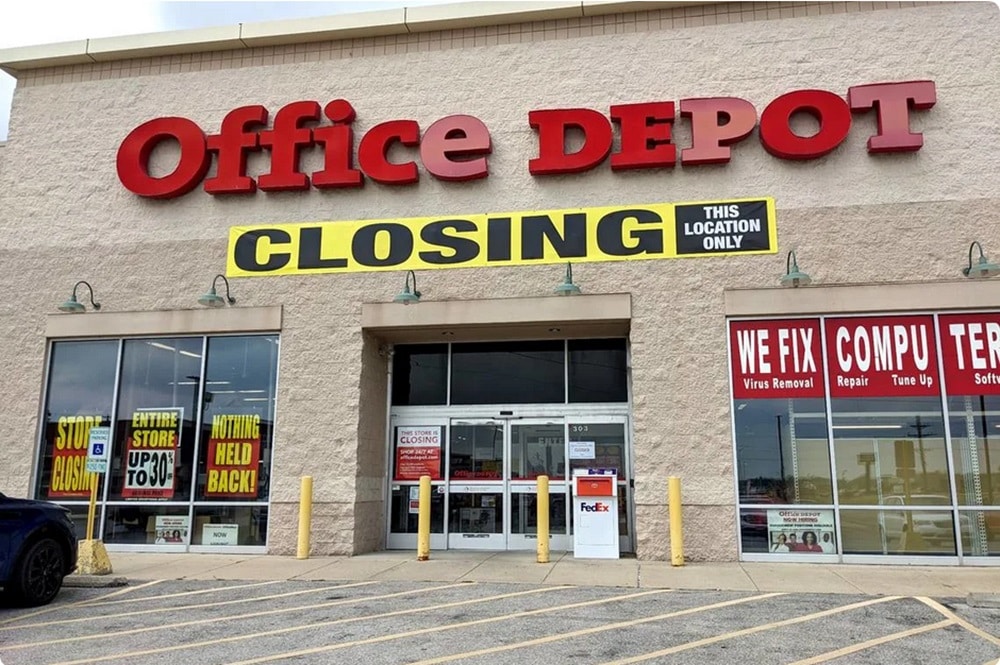The recent announcement of Office Depot closing stores and cutting 13,000 jobs has sent shockwaves through the industry. As the company navigates changes in consumer behavior and the competitive landscape, it is imperative to understand the implications of these decisions. In this blog post, we will delve into the reasons behind Office Depot’s strategic moves and explore the potential impact on employees, customers, and the retail sector as a whole.
The Big Announcement: Office Depot Streamlining Operations
The recent announcement from Office Depot regarding the strategic decision to close stores and cut jobs marks a significant shift in the company’s operational focus. This decision is part of a larger transformation effort aimed at streamlining its operations and adapting to evolving market dynamics.
Overview of Office Depot’s Decision to Close Stores
The decision to close 73 retail locations signifies a deliberate shift away from traditional retail operations towards a more B2B-focused model. This move aligns with Office Depot’s strategy to realign its business units and capitalize on the growing demand for B2B distribution services. The reorganization into distinct business units reflects a concerted effort to optimize resources and enhance efficiency.
The Impact on Employees
As a consequence of the store closures, Office Depot is set to reduce its workforce by 13,000 jobs. This decision, while pivotal for the company’s future trajectory, undoubtedly presents a challenging landscape for the affected employees. The company is likely to provide support and assistance during this transitional phase to mitigate the impact on its workforce.
This strategic realignment underscores Office Depot’s commitment to carving out a stronger position in the market and fostering sustained growth in the B2B segment. The ongoing transformation suggests a proactive approach to capitalizing on emerging opportunities and repositioning the company for long-term success.
Behind the Closures: Reasons for Office Depot’s Restructuring
Shift to Online Shopping
Office Depot’s restructuring is a response to the significant shift in consumer behavior toward online shopping for office supplies. With the increasing convenience and accessibility of e-commerce platforms, customers are opting for the ease of online purchasing, resulting in reduced foot traffic at physical retail locations.
The closure of numerous Office Depot stores is reflective of the company’s strategic adaptation to the evolving preferences of consumers, aligning its operations with the digital era’s dominance. This restructuring aims to optimize resources and cater more effectively to the online consumer base, enhancing the overall shopping experience and operational efficiency.
Competition from Big-Box Retailers and E-commerce Giants
The intensifying competition posed by big-box retailers and e-commerce giants has exerted substantial pressure on Office Depot’s traditional brick-and-mortar business model. Industry leaders such as Amazon, Walmart, and Staples have fortified their online presence, offering a diverse array of office supplies and leveraging expansive distribution networks to reach consumers nationwide.
As consumers gravitate towards these established players, Office Depot has encountered heightened competition, necessitating a strategic reassessment of its retail footprint. The closures reflect the company’s proactive approach to realigning its competitive strategies, fortifying its digital capabilities, and amplifying its competitive edge in the dynamic retail landscape.
Financial Performance and Market Pressures
Amid evolving consumer preferences and intensified market competition, Office Depot has faced financial performance challenges and market pressures, prompting a comprehensive restructuring initiative. The closures of multiple stores serve as a pivotal component of the company’s concerted efforts to streamline operations, enhance cost efficiency, and bolster financial resilience in an increasingly competitive marketplace.
Market pressures, coupled with the imperative to optimize operational costs, have catalyzed Office Depot’s strategic pivot towards a leaner, digitally-driven business model. By strategically consolidating its physical presence, the company endeavors to recalibrate its financial performance, strategically allocate resources, and prioritize sustained growth in a rapidly transforming retail environment.
For more information on the topic, you can visit Office Depot’s recent announcements for insights into the company’s restructuring strategies and market dynamics.
Analyzing the Economic Impact
Consequences for Local Economies
The closure of Office Depot stores and the subsequent job cuts will likely have a significant impact on local economies. With 13,000 jobs being eliminated, there will be a direct effect on consumer spending in the areas where the stores are closing. This reduction in consumer spending could lead to decreased revenue for local businesses, affecting the overall economic stability of these communities. Moreover, the loss of jobs may also lead to an increase in unemployment rates, putting additional strain on local social welfare systems.
Office Depot’s Efforts to Support Affected Workers
In response to the store closures and job cuts, Office Depot has outlined efforts to support affected workers. This includes providing severance packages and job placement assistance to help impacted employees transition to new employment opportunities. Additionally, Office Depot has expressed a commitment to assisting communities affected by the closures through partnerships with local organizations and initiatives aimed at fostering economic recovery.
For more information on the economic impact of store closures and job cuts, you can refer to related sources for a deeper understanding of the ramifications on local economies and the strategies employed by Office Depot to support affected workers.
The Future of Office Supplies Retail
Emerging Trends in Office Supply Purchasing
The future of office supplies retail is being shaped by emerging trends in the industry. With the shift towards remote work and the rise of e-commerce, consumers are increasingly turning to online platforms for their office supply needs. This trend is driven by the convenience and competitive pricing offered by online retailers. Additionally, there is a growing demand for eco-friendly and sustainable office supplies, reflecting a larger societal shift towards environmentally conscious purchasing habits.
How Office Depot Plans to Adapt to Changing Market
In response to these emerging trends, Office Depot has outlined a strategic plan to adapt to the changing market. The company is focusing on expanding its e-commerce capabilities to enhance the online shopping experience for customers. This includes streamlining the ordering process and improving delivery logistics to meet the growing demand for online office supply shopping.
Furthermore, Office Depot is prioritizing the expansion of its range of eco-friendly office supplies to cater to the increasing consumer preference for sustainable products. By aligning with these trends, Office Depot aims to remain competitive and meet the evolving needs of the office supplies retail market.
For further insights on emerging trends in office supply purchasing, visit Industry Insights.
Consumer and Employee Reactions
Public Response to Store Closures and Job Cuts
The recent announcement of Office Depot closing stores and cutting 13,000 jobs has sparked a range of reactions from consumers and employees alike. Many loyal customers have expressed disappointment and concern over the potential inconvenience of losing their local Office Depot store.
With the increasing shift towards online shopping, some consumers have acknowledged the challenges faced by brick-and-mortar retailers in the current market landscape. Employees directly impacted by the job cuts have shared their distress and uncertainty about their future job prospects. The community at large has shown empathy towards those affected, recognizing the impact of such large-scale layoffs on individuals and families.
The Response from the Business Community
Within the business community, the news of Office Depot’s store closures and job cuts has prompted discussions on the evolving retail industry and the implications for the workforce. Business analysts have offered diverse perspectives on the strategic rationale behind the decision, highlighting the competitive pressures faced by traditional office supply retailers in a rapidly changing business environment.
Some industry experts have emphasized the need for companies like Office Depot to adapt to the digital transformation and optimize their operations to remain viable in the long term. Additionally, discussions have emerged regarding the ripple effects on related businesses and the broader economy. This development has catalyzed conversations about the resilience of the retail sector and the measures needed to support displaced workers in transitioning to new employment opportunities.
Comparing Office Depot’s Strategy with Competitors
What Other Companies are Doing Right
As the retail landscape continues to evolve rapidly, many of Office Depot’s competitors have adapted by diversifying their product offerings and expanding their online presence. Companies like Staples and Walmart have successfully integrated their online and offline sales channels, providing customers with a seamless shopping experience. Additionally, they have invested in customer loyalty programs, personalized marketing strategies, and innovative technologies to enhance the overall customer experience. These initiatives have enabled them to stay competitive in the face of changing consumer preferences and market dynamics.
Can Office Depot Bounce Back?
Given the challenging market conditions, Office Depot faces an uphill battle in its efforts to bounce back from store closures and job cuts. However, the company has the opportunity to pivot its strategy by leveraging its remaining physical stores as distribution hubs for online orders.
By focusing on enhancing its e-commerce platform, streamlining its supply chain, and offering unique products and services, Office Depot can carve out a niche and create a compelling value proposition for its customers. Embracing digital transformation, optimizing operational efficiency, and prioritizing customer satisfaction are critical steps for Office Depot to regain its competitive edge in the retail sector.
Conclusion
In conclusion, Office Depot’s decision to close stores and cut jobs is a strategic move aimed at cost reduction and a shift towards prioritizing its IT services business units. The restructuring is projected to generate significant net savings and streamline the company’s operations.
While these changes may bring short-term challenges, the long-term goal is to strengthen the company’s position in the evolving market landscape. Stores like Office Depot, Big Lots, Staples and Walmart continues to adapt to the impact of the COVID-19 pandemic and global business disruptions, its focus on cost efficiency and business unit alignment will be crucial for its future success.









